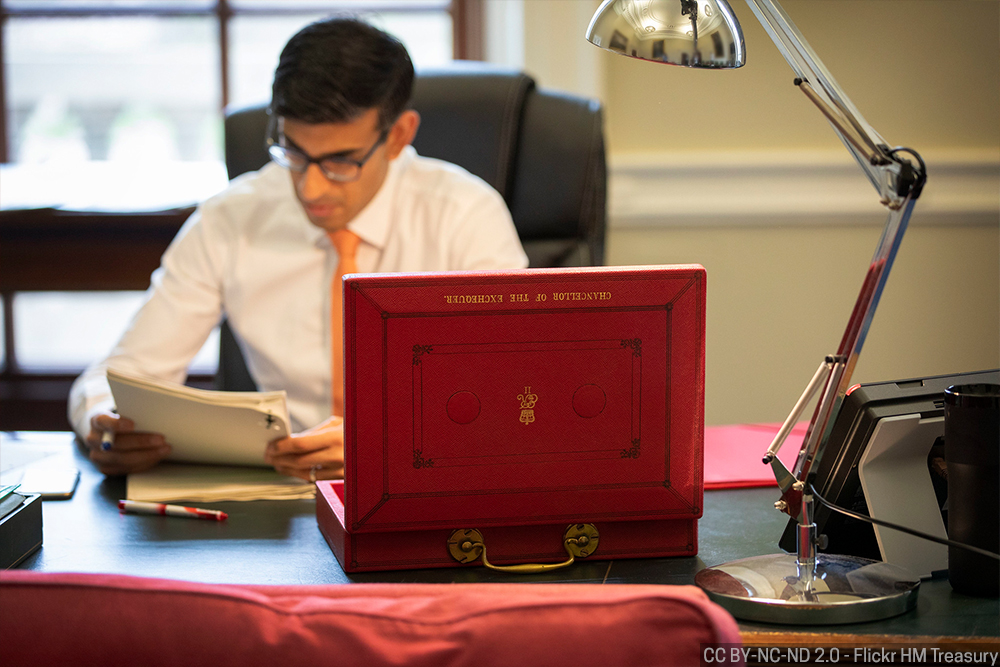Chancellor Rishi Sunak delivered both a Budget and a comprehensive spending review on Wednesday. Health and social care have a much better idea of what their revenue and capital budgets will look like over the next three-years as a result; and there was a headline-grabbing £2.1 billion for tech. Lyn Whitfield looks through the red book and sums up the reaction.
Well, Rishi Sunak got his headlines. This week’s Budget and comprehensive spending review were surely the most heavily trailed Treasury announcements ever, and the chancellor duly picked up mostly positive front pages at the end of his rattling presentation to the Commons.
The devil, as ever, will be in the detail, which tends to emerge more slowly, as economists and lobby groups get to grips with the figures in the Treasury ‘red book’, which this year runs to 195 pages.
Revenue funding:
Some commentators expressed surprise that the NHS received barely a mention in Sunak’s hour-long presentation. However, the health service revenue budget had already been announced.
This was set in September, when prime minister Boris Johnson announced a health and social care levy to tackle first waiting lists and then social care.
The Department of Health and Social Care will see its departmental budget rise from £147.1 billion this year to £177.4 billion in 2024-5, and from this NHS England will see its allocation rise from £136.1 billion to £162.6 billion.
These figures exclude expenditure on Covid-19 and represent an average growth rate of 3.8% over the three years of the CSR; the same as other public spending departments.
However, over the more usual, five-year CSR period that would have started in 2019-20, if the pandemic hadn’t intervened, they represent just 3.1%. Which is below the long-term average growth that the NHS has seen since the second world war.
Whenever funding increases slip below trend, the NHS tends to struggle. And, right now, its cost base is rising rapidly as a result of the general inflation in fuel and food prices, an increase in the national living wage, and the increase in national insurance / health and social care levy contributions.
In addition, £8 billion has been earmarked for tackling the elective backlog; and buried deep in those 195 pages is the startling suggestion that the NHS will be expected to get to 130% of pre-pandemic activity to clear it.
Lord Stevens, the former head of NHS England, suggested that 120% would be required, and that’s what the ‘waiting list accelerators’ are looking to get to, using a mix of analysis, remote tech and new services. So, it’s not clear where the new figure has come from, but one way or another the next three-years look incredibly tight.
Danny Mortimer, deputy chief executive of the NHS Confederation, said health leaders would be “grateful” for what there was and would “do everything in their power to put it to good use” – but “ministers will need to be honest” about what can be done.
Non-NHS health funding:
In the run-up to Wednesday’s announcement, the focus of think-tanks and lobby groups had not been on the NHS revenue budget, but on non-NHS health spending and on the capital budget.
There were widespread calls for Sunak to invest in public health, workforce and education, and social care; and to increase the NHS capital budget to improve facilities and “embed” the “digital innovation” seen during the pandemic.
Public health: In the event, the CSR did little for public health. It maintained the public health grant in real terms “to enable local authorities across the country to continue delivering frontline services like child health visits”; but didn’t reverse the significant cuts that councils have made.
It also found £100 million “to help people achieve and maintain a healthy weight” and £66 million for a Start to Life offer; but this won’t begin to undo the cuts inflicted on Sure Start over the past decade.
Public health experts also pointed out that the distinctly not-net zero Budget’s cuts to aviation, fuel and alcohol duty will exacerbate the significant health problems caused by global heating, pollution, and drinking.
Workforce: Workforce and training commitments were left vague. In his presentation, Sunak claimed the NHS would recruit 50,000 new nurses and deliver 150,000 more primary care appointments; but seemed to forget about the extra 6,000 GPs the government used to promise to deliver them.
Few medical leaders think these people are there to be recruited in any event, and the CSR was unclear on how they will be educated and trained if they are. Sally Warren, the director of policy at the King’s Fund, said in a series of tweets that workforce was the big miss in the chancellor’s statement.
“One massive unanswered question is what the funding is for the workforce – both for the pipeline of new trainees but also the development of the workplace to help retention. Let’s be clear: there is no delivery plan for anything in health and care if there isn’t a workforce plan.”
Social care: Social care did marginally better. The red book says councils will be allowed to raise an additional £1.6 billion a year for adult social care and confirms that the sector will receive £5.4 billion from the £13 billion that will be raised each year by the health and care levy.
Most of this money (£3.6 billion) will go on implementing a cap on personal care costs and reducing means-testing, but around a third (£1.7 billion) will be used to “improve” the system, with £500 million ringfenced for staff training and welfare.
Again, though, social care is struggling and its cost-base will be hit by inflation, which the Office for Budget Responsibility reckons could hit 5.4%, wages and NI. Nigel Edwards, the chief executive of the Nuffield Trust, said: “The government has handed the sector an increase in funding with one hand but taken it away with another… at a time when vacancies are spiraling.
“Without transformative funding, we aren’t going to see the real changes required to truly fix social care.” Meanwhile, the sector continues to lack strategic direction, since the promised white paper has yet to emerge.
The capital budget
There was also relatively good news on capital funding, which will rise from £9.4 billion this year to £11.2 billion in 2024-5. Overall, that’s another rise of 3.8% on average, so it meets think-tank demands for the NHS capital budget to keep pace with the revenue budget.
On the other hand, the NHS maintenance backlog has reached £9.2 billion; and the red book suggests that an awful lot of money has been earmarked for more eye-catching initiatives.
Section 4.4 of the red book says that over the next three years, £4.2 billion will go into the new hospital programme. Another £2.3 billion will go into diagnostic services and, specifically, “at least 100” community diagnostic centres”, while £1.5 billion will into surgical hubs.
That will generate a lot of good local paper headlines; but it will severely reduce the NHS’ ability to tackle its £9 billion-plus backlog maintenance file or flex facilities in response to local requirements.
Saffron Cordery, the deputy chief executive of NHS Providers, said trust leaders would welcome the money, but “there are significant questions” over whether it will be enough to deliver the government’s new hospitals pledge and other commitments. She also queried how the promised new facilities will be staffed, given the lack of attention given to workforce in Wednesday’s announcement.
£2.1 billion for health tech
Section 4.4 of the redbook also confirms that £2.1 billion will be set aside for “innovative use of digital technology, so hospitals and other care organisations are as connected and efficient as possible, freeing up valuable NHS staff time and ensuring the best care for patients wherever they are.”
The Times chose to lead its pre-Budget coverage with this funding and headlined its story: “Chancellor to spend billions to digitise the NHS.” However, £2.1 billion is hardly “billions”, particularly in the context of attempts to “digitise the NHS”.
The National Programme for IT was a £12.7 billion project, while former health secretary Jeremy Hunt secured £4.2 billion for ‘Paperless 2018’. Having said that, it is considerably more than the digital ‘aspirants’ have received over the past couple of years, and double what’s available in the unified tech fund.
What the red book doesn’t say is how the money will be spread across the CSR period – whether there will be £700 million a year, or the cash will be front or back-weighted.
Nor does it say whether it will be kept back for national initiatives and headline grabbing projects or distributed to integrated care systems and providers. NHSX’s recent ‘what does good look like’ and ‘who pays for what’ documents suggest the latter.
They say that once the UTF closes in March, everything except national infrastructure, products (like the NHS App) and software (like Microsoft 365) will be the responsibility of ICSs so IT funding can be aligned with strategic and business objectives. But time will tell.
Overall:
In his speech, the chancellor argued that “as the economy recovers, we have two choices: to retrench or to invest.” Whitehall and the public services will be glad that he decided not to retrench, even if he didn’t invest to the point of undoing a decade of austerity.
The NHS has secured a revenue settlement for the next three years that is close to long-term trend, and investment in some specific areas, including reducing waiting lists and the diagnostic and surgical hubs the government hopes will make a significant contribution to that effort.
There is money going into health tech, even if the detail that underpins that £2.1 billion subhead is still very much to come. However, the NHS revenue funding comes after a very long period of under-investment that had left it under pressure and short of staff before the pandemic hit.
And getting to 130% of pre-Covid activity, if that is what is required to eliminate the elective backlog in three-years, would be nothing short of heroic. Saffron Cordery from NHS Providers summed up: “NHS leaders recognise and welcome the significant extra revenue and capital funding the government has now provided to the service.
“They are deeply committed to delivering better care and improving health outcomes for this new investment. But long-standing fault lines have been significantly exacerbated by the impact of Covid-19 and they cannot be addressed overnight.”
The health tech industry should not expect a bonanza after Wednesday. Its big challenge is still to make the case tht it can support a service under huge pressure with only limited headroom to invest to do things differently. But the good news is that there are some significant new projects to align with and that there may be just a little more headroom, if that £2.1 billion is used wisely.



